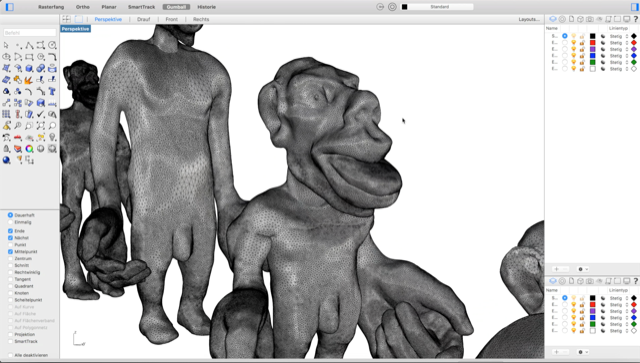Digital Homunculus
Von Text zu Material

Der Penfield-Homunculus stellt dar, wie der menschliche Körper im Gehirn abgebildet wird. Entwickelt durch den Neurochirurgen Wilder Penfield (1891-1976), zeigt dieser Homunculus den menschlichen Körper in den Größenverhältnissen, die seiner Repräsentation auf der Hirnoberfläche entsprechen. So beanspruchen Hand und Mund dort relativ großen Raum, während Stirn und Knie etwa eng umschrieben sind.
Unser Projekt überträgt das Konzept des Penfield-Homunculus auf das Gebiet der Digital Humanities und des Computational Designs. Durch die Zusammenarbeit von Informatikern, Geisteswissenschaftlern und Gestaltern wird die Darstellung, die der menschliche Körper in exemplarischen Diskursen erfährt, in physische Homunculus-Figuren übersetzt.
Ausgangspunkt sind digitale Textkorpora einzelner Philosophen, u. a. die Werke von Kant, Hegel und Freud. Diese Textkorpora wurden mit Hilfe eines linguistischen Modells, das relevante Aspekte des menschlichen Körpers abbildet, ausgewertet. Die Ergebnisse bildeten die Grundlage für die digitale Modellierung der Homunculus-Skulpturen, die dann im 3D-Druckverfahren hergestellt wurden.
Die „philosophischen Körper“, die auf diese Weise entstehen, sollen der Verdeutlichung dienen. Indem sie einen Aspekt der ausgewählten philosophischen Texte nicht nur abbilden, sondern buchstäblich greifbar machen, laden sie zu näheren Betrachtungen und weiteren Vergleichen ein – und führen dadurch zur Lektüre der Texte zurück.
Eine Machbarkeitsstudie wurde anlässlich der Bauhaus-Summaery 2018 gemeinsam von der Fakultät Medien und der Fakultät Kunst und Gestaltung vorgestellt.
Professoren: Henning Schmidgen, Benno Stein, Jan Willmann
Mitarbeiter: Michael Braun, Tim Gollub
/
The “Penfield homunculus” illustrates the representation of the human body in the human brain. Suggested by neurosurgeon Wilder Penfield (1891-1976), this homunculus shows the human body in correspondence to the size of the body’s representation on the cortex. For example, Hand and mouth are distributed over rather vast amounts of space, whereas forehead and knee occupy only limited areas.
“Philosophical Bodies” transfers the Penfield homunculus from the realm of the neurosciences and applies it the fields of Digital Humanities and Computational Design. Computer scientists, humanities scholars, and designers, collaborate in order to decipher the textual representations of the human body in exemplary discourses and turn these representations into homunculus sculptures.
Our starting point were digitized texts from philosophers, such as the collected works of Kant, Hegel, Freud and others. We analyzed theses corpuses by means of a linguistic model representing relevant aspects of the human body. We then took the corresponding results as the basis for the digitally modeling and 3D printing of the homunculus sculptures.
The resulting “Philosophical Bodies” do not just visualize a specific aspect or topic implied in the corresponding texts. The present sculptures enable us to literally grasp this aspect, inviting us to close considerations and broad comparison – thereby leading us back to reading the texts again.
A feasibility study was presented jointly by the Faculty of Media and the Faculty of Art and Design on the occasion of Bauhaus Summaery 2018.
Professors: Henning Schmidgen, Benno Stein, Jan Willmann
Scientific staff: Michael Braun, Tim Gollub